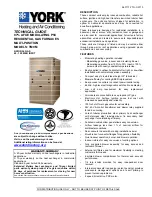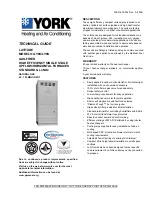
17
Altitude
Gas
Kit
Manifold
Pressure
Pressure
Sensor
Natural
None
0 - 4500
None
3.0" w.c.
Table 5
Gas Piping Connections
T
O
AVOID
POSSIBLE
UNSATISFACTORY
OPERATION
PMENT
,
USE
THE
PROPER
SIZE
OF
NATURAL
GAS
PIPING
NEEDED
WHEN
RUNNING
PIPE
FROM
THE
METER
TO
THE
FURNACE
.
OR
EQUIPMENT
DAMAGE
DUE
TO
UNDERFIRING
OF
EQU
I
WARNING
When sizing gas lines, be sure to include all appliances on the
same gas supply line and which will operate simultaneously.
The gas piping supplying the furnace must be properly sized
based on the gas flow required, specific gravity of the gas,
and length of the run. The gas line installation must comply
with local codes, or in their absence, with the latest edition of
the National Fuel Gas Code, NFPA 54/ANSI Z223.1.
Natural Gas Capacity of Pipe
In Cubic Feet of Gas Per Hour (CFH)
Length of
Nominal Black Pipe Size
Pipe in Feet
1/2"
3/4"
1"
1 1/4"
1 1/2"
10
132
278
520
1050
1600
20
92
190
350
730
1100
30
73
152
285
590
980
40
63
130
245
500
760
50
56
115
215
440
670
60
50
105
195
400
610
70
46
96
180
370
560
80
43
90
170
350
530
90
40
84
160
320
490
100
38
79
150
305
460
(Pressure 0.5 psig or less and pressure drop of 0.3" W.C.; Based on
0.60 Specific Gravity Gas)
CFH = BTUH Furnace Input
Heating Value of Gas (BTU/Cubic Foot)
Table 6
To connect the furnace to the building’s gas piping, the installer
must supply a ground joint union, drip leg, manual shutoff
valve, and line and fittings to connect to gas valve. In some
cases, the installer may also need to supply a transition piece
from 1/2” pipe to a larger pipe size.
The following stipulations apply when connecting gas piping.
•
Gas piping must be supported external to the furnace
cabinet so that the weight of the gas line does not
distort the burner rack, manifold or gas valve.
•
Use black iron or steel pipe and fittings for the building
piping. Where possible, use new pipe that is properly
chamfered, reamed, and free of burrs and chips. If
old pipe is used, be sure it is clean and free of rust,
scale, burrs, chips, and old pipe joint compound.
•
Use pipe joint compound on male threads ONLY.
Always use pipe joint compound (pipe dope) that
is APPROVED FOR ALL GASSES. DO NOT apply
compound to the first two threads.
•
Use ground joint unions.
•
Install a drip leg to trap dirt and moisture before it can
enter the gas valve. The drip leg must be a minimum
of three inches long.
•
Install a 1/8” NPT pipe plug fitting, accessible for test
gage connection, immediately upstream of the gas
supply connection to the furnace.
• Always use a back-up wrench when making the
connection to the gas valve to keep it from turning.
The orientation of the gas valve connection is 374
in-lbs; excessive over-tightening may damage the
gas valve and/or gas manifold assembly.
• Install a manual shutoff valve between the gas
meter and unit within six feet of the unit. If a union
is installed, the union must be downstream of the
manual shutoff valve, between the shutoff valve and
the furnace.
•
Tighten all joints securely.
• Protect connectors and semi-rigid tubing against
physical and thermal damage when installed. Ensure
aluminum-alloy tubing and connectors are coated to
protect against external corrosion when in contact
with masonry, plaster, or insulation, or subjected to
repeated wetting by liquids such as water (except rain
water), detergents, or sewage. The gas piping may
enter the left or right side of the furnace cabinet. The
installer must supply rigid pipe long enough to reach
the outside of the cabinet to seal the grommet cabinet
penetration. A semi-rigid connector to the gas piping
can be used outside the cabinet per local codes. 1/2”
NPT pipe and fittings are required. Model requires
one 90 deg elbow, one 2” nipple and additional nipple
to reach outside the cabinet. A semi-rigid connector
to the gas piping can be used outside the cabinet
per local codes. From the elbow, the length of pipe
and the fittings required will vary by the side chosen,
location of union and cabinet width. The union may
be placed inside or outside of the cabinet.
General Furnace Layout
Figure 11
















































